

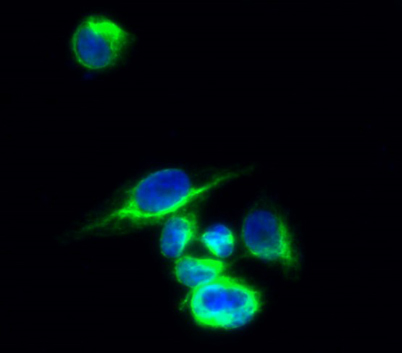
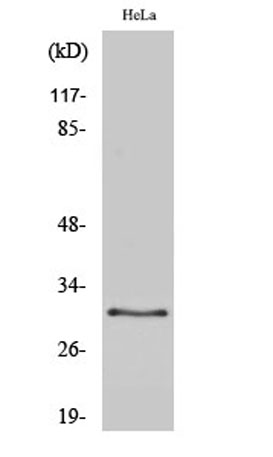
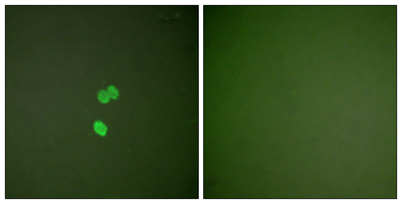
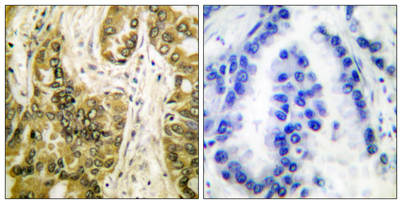
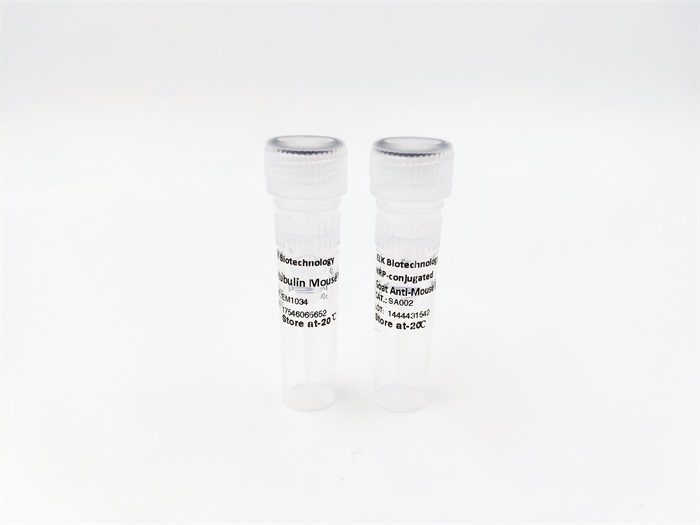



CBP 35 rabbit pAb
 One-click to copy product information
One-click to copy product information$148.00/50µL $248.00/100µL
| 50 µL | $148.00 |
| 100 µL | $248.00 |
Overview
| Product name: | CBP 35 rabbit pAb |
| Reactivity: | Human;Mouse;Rat |
| Alternative Names: | LGALS3; MAC2; Galectin-3; Gal-3; 35 kDa lectin; Carbohydrate-binding protein 35; CBP 35; Galactose-specific lectin 3; Galactoside-binding protein; GALBP; IgE-binding protein; L-31; Laminin-binding protein; Lectin L-29; Mac-2 antigen |
| Source: | Rabbit |
| Dilutions: | Western Blot: 1/500 - 1/2000. Immunohistochemistry: 1/100 - 1/300. Immunofluorescence: 1/200 - 1/1000. ELISA: 1/20000. Not yet tested in other applications. |
| Immunogen: | The antiserum was produced against synthesized peptide derived from human Galectin 3. AA range:141-190 |
| Storage: | -20°C/1 year |
| Clonality: | Polyclonal |
| Isotype: | IgG |
| Concentration: | 1 mg/ml |
| Observed Band: | 33kD |
| GeneID: | 3958 |
| Human Swiss-Prot No: | P17931 |
| Cellular localization: | Cytoplasm . Nucleus. Secreted . Secreted by a non-classical secretory pathway and associates with the cell surface. Can be secreted; the secretion is dependent on protein unfolding and facilitated by the cargo receptor TMED10; it results in protein translocation from the cytoplasm into the ERGIC (endoplasmic reticulum-Golgi intermediate compartment) followed by vesicle entry and secretion (PubMed:32272059). . |
| Background: | This gene encodes a member of the galectin family of carbohydrate binding proteins. Members of this protein family have an affinity for beta-galactosides. The encoded protein is characterized by an N-terminal proline-rich tandem repeat domain and a single C-terminal carbohydrate recognition domain. This protein can self-associate through the N-terminal domain allowing it to bind to multivalent saccharide ligands. This protein localizes to the extracellular matrix, the cytoplasm and the nucleus. This protein plays a role in numerous cellular functions including apoptosis, innate immunity, cell adhesion and T-cell regulation. The protein exhibits antimicrobial activity against bacteria and fungi. Alternate splicing results in multiple transcript variants.[provided by RefSeq, Oct 2014], |
-
 Immunofluorescence analysis of Hela cell. 1,CBP 35 Polyclonal Antibody(green) was diluted at 1:200(4° overnight). 2, Goat Anti Rabbit Alexa Fluor 488 Catalog:RS3211 was diluted at 1:1000(room temperature, 50min). 3 DAPI(blue) 10min.
Immunofluorescence analysis of Hela cell. 1,CBP 35 Polyclonal Antibody(green) was diluted at 1:200(4° overnight). 2, Goat Anti Rabbit Alexa Fluor 488 Catalog:RS3211 was diluted at 1:1000(room temperature, 50min). 3 DAPI(blue) 10min. -
 Western Blot analysis of various cells using CBP 35 Polyclonal Antibody diluted at 1:2000
Western Blot analysis of various cells using CBP 35 Polyclonal Antibody diluted at 1:2000 -
 Immunofluorescence analysis of NIH/3T3 cells, using Galectin 3 Antibody. The picture on the right is blocked with the synthesized peptide.
Immunofluorescence analysis of NIH/3T3 cells, using Galectin 3 Antibody. The picture on the right is blocked with the synthesized peptide. -
 Immunohistochemistry analysis of paraffin-embedded human lung carcinoma tissue, using Galectin 3 Antibody. The picture on the right is blocked with the synthesized peptide.
Immunohistochemistry analysis of paraffin-embedded human lung carcinoma tissue, using Galectin 3 Antibody. The picture on the right is blocked with the synthesized peptide.

 Manual
Manual